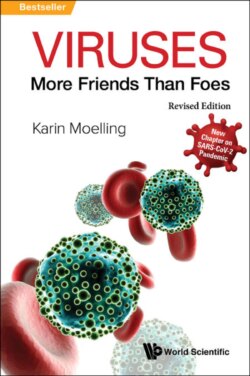Читать книгу Viruses: More Friends Than Foes (Revised Edition) - Karin Moelling - Страница 39
На сайте Литреса книга снята с продажи.
“Naked DNA”
ОглавлениеOne day in the 1990s I received an unexpected invitation to Malvern, Pennsylvania, USA. I had earlier been an adviser there, for several years, for the company Centocor for the application of cancer genes in the diagnosis or therapy of cancer. The project now was a vaccine against HIV, and a spinoff of Centocor by the name Apollon was founded. I was supposed to direct the development of that vaccine and received an impressive business card as CSO, Chief Scientific Officer, for a very small team! I was on leave from the Max Planck Institute in Berlin for one week per month; my time at the computer was not recorded. The science was exciting: the goal was a naked DNA vaccine, a novelty then, whereby the muscle of a vaccinee is injected with DNA to produce parts of the virus, some proteins, simulating infection. This should lead to antibodies in the recipient as vaccine. The DNA was a complex combination of a variety of viral genes, amplifying genes, some of which originated from totally different other viruses or even bacteria. That is the playground of virologists but also the art — the secret lies in the selection, cutting and recombining genes to intensify certain properties and to avoid others, as modules of an artificial virus. That was the challenge. No intact pathogenic virus is allowed to emerge from the process. And in clinical tests, or the customs at the US border, it should be clear that the carrier has not been infected but only vaccinated.
While we were producing large amounts of the DNA, suddenly all samples, text-tubes and reagents were found to be contaminated with the DNA. There was a leak somewhere — until we could repair it in the safety laboratory, we were all already vaccinated through the air and our nose and lungs. The DNA was safe! It was further modified to a “dummy” so that it could not be stolen or imitated by competitors — a normal precaution in industry, but less so in a research laboratory — and new to me.
The DNA was then tested in some HIV-infected patients in Zurich. This was the first DNA-based vaccine in Europe. “Adverse events” did not occur in the patients within several years. (The most important thing was that the volunteers did not develop autoimmune responses.)
However, unexpectedly, the local immunologists at the University showed “severe adverse” behavior — maybe because we were invading their “territory”? I tried to co-operate before we started injecting the patients, but failed. I had initiated the project before I came to Zurich — still something to remember for others if one wants to avoid trouble.
After the injections we noticed that one patient had been infected with a “wrong” HIV strain, which could not be recognized by the vaccine. After a first shock this was not a real problem because a Phase I Clinical Trial in patients is normally only a safety test. Of course we would have liked to see some efficacy, some protection, even though that is not the purpose of such a trial. The DNA construct is now in use in the U.S. military, but in combination with other vaccines. Especially a sequential approach is attractive, “prime-boost”, in this case a DNA-prime — and virus boost. The virus is a modified Adenovirus with HIV landmarks, because virus particles lead to best immune responses. The DNA vaccine has apparently a training effect on immune cells, making them into long-lived memory cells. We observed that as an unexpected effect. The virus for the boost is sometimes constructed to contain rare triplets, designated as “codon deoptimization”; this slows down the virus production. Such attenuation, which is frequently intended for vaccines, results in the viruses being unable to cause diseases. Real but slowed-down viruses have been used as the basic principle for vaccines in the past. To administer DNA, injection-needles are no longer used; pistols are now applied to shoot the DNA into the muscles. I have such a pistol in a safety box with a red velvet lining, delivered by the producer, making it look very valuable — however, we did not find this type of injection very effective. Better pistols may have to be designed. This type of DNA vaccination is used worldwide in many variants: against influenza, respiratory-syncytial or Ebola and the newly emerging Zika viruses. Yet DNA alone is too inefficient, so combinations with other vaccines are required. In contrast to viruses, cancer cells often do not expose foreign proteins on their surface, so that one cannot train the immune system easily to recognize them as targets for antibody production. One therefore tries recently to exploit not antibody production but rather the stimulation of cell-mediated immunity, by growing lymphocytes with DNA coding for cytokines. We therefore injected such an (interleukin-12-producing) DNA into malignant melanoma patients in a clinical trial — with some effect (see below). Help for self-help is the idea.
